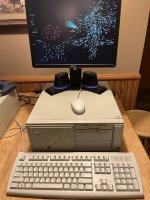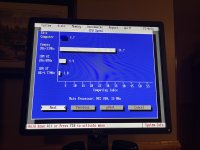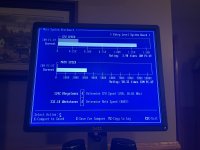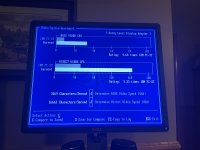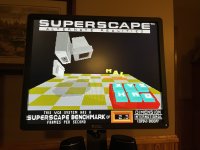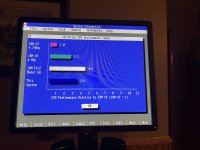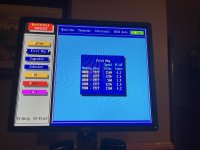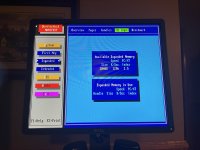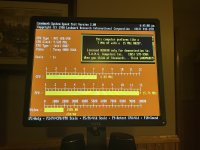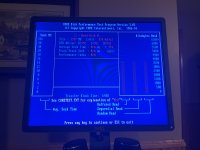jasa1063
Experienced Member
I posted back in March of this year about my Juko Nest N3 NEC V30 10MHz build that I acquired. The link below is to my post on Vogons:
Re: Juko Nest N3 XT system w/NEC V30 Acquisition/Build
Here is my original post here for this build:
Some of my benchmarks came up a bit short against the legendary Anonymous Coward's "V'ger XT. I wanted to get to the bottom of what made my system slightly slower and I think I finally have those answers. All of my benchmarks now equal or exceed that system. What has changed in the last 7 months? Changing the video card to a Diamond Speedstar ET4000, a bit more testing and some key software tweaks. I had erroneously assumed the system was already running at zero wait states reading from the wait state configuration register at port 70H which always came back as zero. I came to find out that the register is write only. It was only after trying different values that I actually was able to tweak the system to the point it made a real difference. It turns out the memory is at zero wait states, but the ISA bus is set to 3 wait states in the default configuration. I was able to get the ISA bus to 1 wait state and this made a big difference as the benchmarks will show. The 2nd thing was tweaking the memory refresh rate. I now use a value of 500us which is stable and results in measurable increase in overall system performance.
The website for Anonymous Coward's "V'ger XT is no longer online. Here is a link to that webpage on archive.org for reference:

 web.archive.org
web.archive.org
I decided to move this motherboard from a tower to desktop computer case. I really think XT class systems belong in desktop case. This of course did not change the performance, but I now think it has the proper ascetic look. Included is a picture of the new case.
I am also uploading the set of tweaking utilities I used. DRAM simply sets the memory refresh period. In my case I use DRAM 500 for a 500us memory refresh period. Also included are 3 small utilities created with debug for tweaking the wait state configuration register at port 70H. WS0 tries to set everything to zero wait states, but completely locks up my computer. I am only including it for testing purposes in case anyone else has better luck. WS1 sets the the ISA bus to 1 wait state and RAM & ROM to zero wait states. This is what I use for when I boot the system. WS3 is simply the default state as if no tweaks were applied. I figured this out during my testing. Please note the 3 wait state utilities should just be used with a Juko Nest N3. I also have a Juko ST motherboard and while that uses port 70H, just like the Nest N3, they are slightly different in my experience.
Re: Juko Nest N3 XT system w/NEC V30 Acquisition/Build
Here is my original post here for this build:
Some of my benchmarks came up a bit short against the legendary Anonymous Coward's "V'ger XT. I wanted to get to the bottom of what made my system slightly slower and I think I finally have those answers. All of my benchmarks now equal or exceed that system. What has changed in the last 7 months? Changing the video card to a Diamond Speedstar ET4000, a bit more testing and some key software tweaks. I had erroneously assumed the system was already running at zero wait states reading from the wait state configuration register at port 70H which always came back as zero. I came to find out that the register is write only. It was only after trying different values that I actually was able to tweak the system to the point it made a real difference. It turns out the memory is at zero wait states, but the ISA bus is set to 3 wait states in the default configuration. I was able to get the ISA bus to 1 wait state and this made a big difference as the benchmarks will show. The 2nd thing was tweaking the memory refresh rate. I now use a value of 500us which is stable and results in measurable increase in overall system performance.
The website for Anonymous Coward's "V'ger XT is no longer online. Here is a link to that webpage on archive.org for reference:

Anonymous Coward's "V'ger XT" - 10MHz V30
A Website all about a heavily modified IBM PC/XT
I decided to move this motherboard from a tower to desktop computer case. I really think XT class systems belong in desktop case. This of course did not change the performance, but I now think it has the proper ascetic look. Included is a picture of the new case.
I am also uploading the set of tweaking utilities I used. DRAM simply sets the memory refresh period. In my case I use DRAM 500 for a 500us memory refresh period. Also included are 3 small utilities created with debug for tweaking the wait state configuration register at port 70H. WS0 tries to set everything to zero wait states, but completely locks up my computer. I am only including it for testing purposes in case anyone else has better luck. WS1 sets the the ISA bus to 1 wait state and RAM & ROM to zero wait states. This is what I use for when I boot the system. WS3 is simply the default state as if no tweaks were applied. I figured this out during my testing. Please note the 3 wait state utilities should just be used with a Juko Nest N3. I also have a Juko ST motherboard and while that uses port 70H, just like the Nest N3, they are slightly different in my experience.
Attachments
Last edited:

